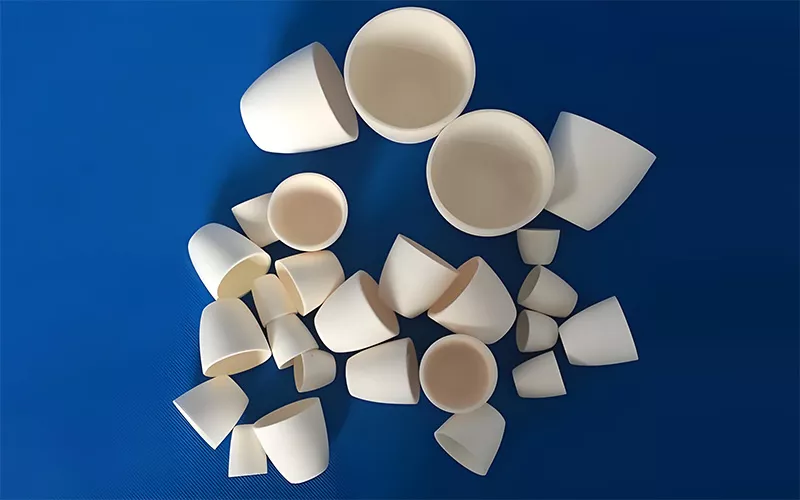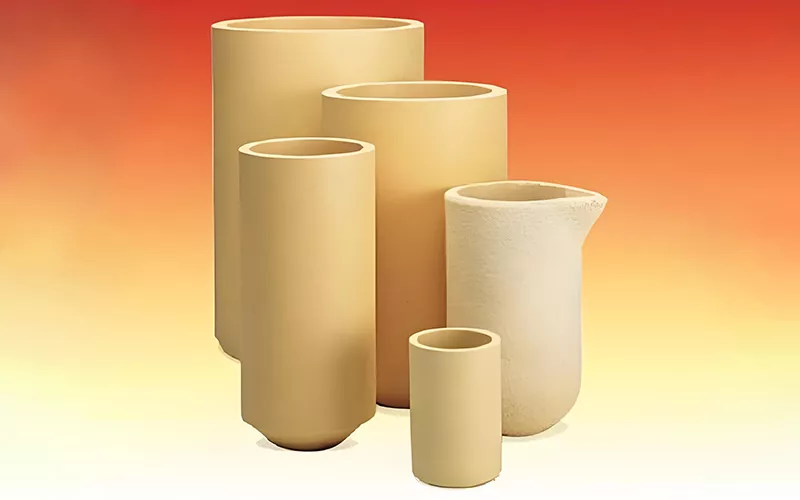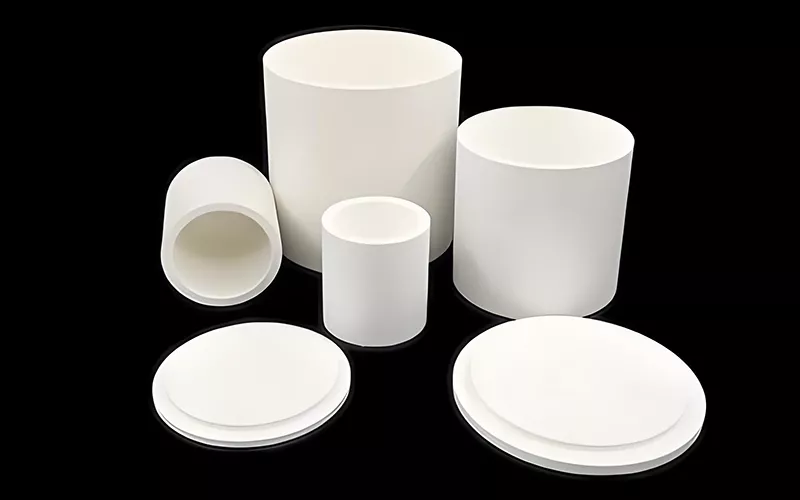Ceramic crucibles are containers with high melting points and high temperature resistance. They combine chemical stability with a low coefficient of thermal expansion, making them essential tools for extremely high-temperature applications in laboratories, metallurgy, semiconductor manufacturing, and other fields.
Ceramic crucibles are primarily made from advanced ceramics such as 알루미나, 질화붕소, 그리고 산화지르코늄. In this article, we’ll explore ceramic crucible material selection, key characteristics, and service life to help you select the most suitable crucible for your high-temperature application.

세라믹 도가니의 재료는 무엇입니까?
알루미나 도가니
알루미나 세라믹 도가니 are primarily made of 99.7% pure aluminum oxide. Did you know? During the production process, many manufacturers, such as GORGEOUS, add small amounts of magnesium oxide (MgO) and silicon dioxide (SiO2) to impart superior physical and chemical properties to the crucibles.
Key Features: High-Temperature Resistance - Alumina crucibles can withstand temperatures of approximately 1700°C in a redox atmosphere. While offering superior performance, alumina crucibles are also price-competitive, making them the preferred material for many manufacturers.
Applications: Alumina crucibles are primarily used in laboratory and industrial metallurgy, heating, and chemical reactions.
Advantages: Alumina crucibles are one of the most economical ceramic crucibles on the market. Alumina’s high melting point and low thermal expansion coefficient make them resistant to cracking. They are ideal reaction vessels for weakly alkaline substances.
Limitations: Strongly corrosive substances, such as the strong base sodium hydroxide (NaOH), can severely damage alumina crucibles. For these materials, GORGEOUS recommends using a crucible material with strong corrosion resistance instead of alumina crucible.
지르코니아 도가니
Zirconia crucibles are primarily made of high-purity zirconium oxide. Their exceptionally high temperature resistance and chemical stability make them ideal for extremely high-temperature melting processes.
Key Features: Zirconia crucibles boast robust high-temperature resistance, capable of withstanding temperatures up to 2000°C, making them ideal for melting precious metals such as platinum (Pt) and palladium (Pd).
Zirconium oxide also possesses excellent chemical resistance, maintaining a stable structure even in harsh environments with strong acids and alkalis, making it an ideal crucible material for processes prone to corrosion.
Applications: Zirconia crucibles are primarily used in precious metal melting and certain processes involving high-melting-point materials.
지르코니아 강화 알루미나 도가니(ZTA 도가니)
Zirconia-toughened alumina crucibles (ZTA) are primarily made of 90% alumina and 10% zirconia. This ceramic material combines the advantages of both alumina and zirconia, offering excellent high-temperature resistance and high toughness.
주요 특징:
High Toughness - The addition of zirconia significantly improves the crucible’s crack and wear resistance, reducing damage caused by high temperatures and mechanical shock.
High-Temperature Resistance - ZTA crucibles can withstand temperatures up to 1700°C and operate stably in high-temperature environments.
Thermal Shock Resistance - Compared to pure alumina crucibles, ZTA crucibles offer higher thermal shock resistance, are more stable under severe temperature fluctuations, and are less prone to cracking.
Applications: These crucibles are primarily used in processes requiring high mechanical strength and high-temperature stability.
질화붕소 도가니(PBN 도가니)
Boron nitride crucibles are specially designed for use at extremely high temperatures. Their primary component is pyrolytic boron nitride.
주요 특징:
High-Temperature Resistance - Boron nitride crucibles offer exceptional high-temperature resistance. In a protective atmosphere, they can reach temperatures of up to 2100°C and remain stable. They will not melt or react chemically with the substrate at extremely high temperatures.
Thermal Conductivity - Boron nitride crucibles have excellent thermal conductivity, allowing them to quickly dissipate heat, effectively preventing localized overheating, thermal stress, and thermal damage.
Low Thermal Expansion Coefficient - Boron nitride has a low thermal expansion coefficient, effectively reducing the risk of crucible cracking in high-temperature processes requiring rapid cooling or heating.
Applications: Boron nitride crucibles are primarily used in high-temperature processes such as semiconductor manufacturing and metal smelting. In the semiconductor industry, they are often used in chemical vapor deposition (CVD), crystal growth, and high-temperature evaporation.
기타 세라믹 재료
위에서 언급한 일반적인 세라믹 재료 외에도 산화마그네슘과 산화베릴륨과 같은 고품질 도가니 재료도 있습니다. 이러한 재료는 모두 우수한 고온 성능을 가지고 있으며, 많은 금속 제련 및 실험실에서 필수적인 도가니 용기 재료입니다.
Crucible의 사용 수명을 보장하려면 어떻게 해야 하나요?
If you want your crucible to have better performance and service life, you’d better do the following:
저장:
사용한 도가니는 습기와 오염을 흡수하지 않도록 건조하고 깨끗한 환경에 보관하는 것이 가장 좋습니다. 화학 물질 근처나 습도가 높은 곳에 도가니를 보관하는 것은 피해야 합니다.
작동하다:
도가니를 작동할 때는 적절한 도구를 사용해야 하며, 손과의 직접 접촉을 피하고 사용 후에는 균열이나 손상이 있는지 확인해야 합니다.
청소:
사용 후에는 도가니를 깨끗이 세척해야 합니다. 모든 잔여물을 제거하고, 열 충격과 균열을 방지하기 위해 세척 전에 충분히 식히도록 주의하십시오.
자주 묻는 질문
1. 도가니란 무엇인가요?
도가니는 매우 높은 온도에서 사용하도록 설계된 용기로, 주로 금속 제련과 화학 반응에 사용됩니다.
2. 세라믹 도가니의 녹는점은 무엇입니까?
세라믹 도가니의 녹는점은 주로 사용되는 재료에 따라 달라집니다. 예를 들어, 알루미나 도가니는 1650°C에서 1700°C 사이의 온도를 견딜 수 있는 반면, 지르코니아 도가니는 최대 2000°C의 온도를 견딜 수 있습니다.
3. 화학에서 세라믹 도가니의 용도는 무엇입니까?
세라믹 도가니는 고온 금속 제련, 화학 반응 용기, 재료 처리 용기 등에 자주 사용됩니다.
4. 세라믹 도가니의 기능은 무엇입니까?
세라믹 도가니는 주로 고온 가열, 재료의 용융 또는 정제 등에 사용됩니다. 또한 일부 화학 반응의 용기 역할도 할 수 있습니다.
5. 세라믹 도가니의 재료적 특성은 무엇입니까?
세라믹 소재는 높은 융점, 낮은 열팽창 계수, 우수한 열 안정성, 내화학성 등의 특성을 가지고 있습니다.
6. 세라믹 도가니를 사용하면 강알칼리성 물질을 녹일 수 있나요?
이는 주로 도가니의 재질에 따라 달라집니다. 일반적으로 수산화나트륨(NaOH)이나 과산화나트륨(Na₂O₂)과 같은 강알칼리성 물질을 녹일 때는 알루미나 도가니를 사용하지 않는 것이 좋습니다. 이러한 물질은 도가니를 부식시킬 수 있기 때문입니다.
7. 도자기 도가니와 세라믹 도가니의 차이점은 무엇입니까?
도자 도가니는 일반적으로 도자 재질로 제작된 도가니를 말합니다. 세라믹 도가니는 기존 도자 도가니보다 성능이 뛰어나고, 더 높은 온도를 견딜 수 있으며, 기계적 특성도 더 우수합니다.
8. 세라믹 도가니를 가열하는 방법은?
세라믹 도가니를 가열할 때는 도가니 재질의 특성에 따라 적절한 가열 방법을 선택해야 합니다. 가열 중 급격한 냉각이나 가열은 도가니 균열의 원인이 될 수 있으므로 피해야 합니다.
9. 세라믹 도가니의 유지관리 방법은 무엇인가요?
도가니를 사용한 후에는 잔여물을 제거하기 위해 철저히 세척해야 하며, 적절한 세척액을 사용하여 세척하고 마지막으로 순수한 물로 헹구고 말려서 나중에 사용해야 합니다.
결론
Ceramic crucibles are indispensable tools in modern chemistry and metallurgy. Capable of operating in extreme temperatures and harsh chemical environments, they play a key role in a wide range of scientific and industrial applications. GORGEOUS, a leading international supplier of advanced ceramics, offers custom-made ceramic crucibles in a variety of materials. Thank you for reading this article, and we hope you find it helpful.